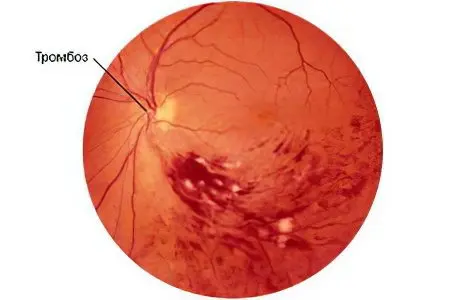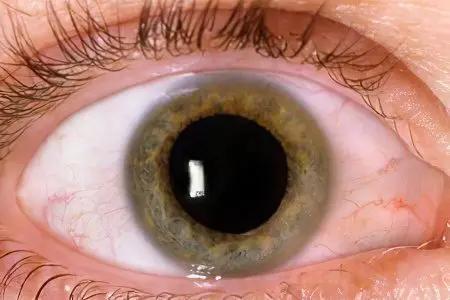Contents
What is retinal thrombosis?
retinal thrombosis is an eye disease caused by an acute circulatory disorder in the central retinal vein (CRV). Synonyms of CVD thrombosis: venous stasis retinopathy, hemorrhagic retinopathy.
Depending on the localization, retinal vein thrombosis is divided into occlusion (blockage) of the central vein itself and blockage of its branches. With occlusion of branches, only the peripheral part of the retina, which was supplied with blood by the affected branch, is involved in the pathological process, and with blockage of the central vein, most of the retina, since in this case the thrombus is located at the level of the optic nerve. Therefore, the symptoms and prognosis in these two cases are somewhat different.
The incidence of CVD thrombosis is 2,14 per 1000 people, and among patients with glaucoma it is 17,3 per 1000 people. The disease is observed mainly in people over the age of 40 years, the average age of patients is 51–65 years. Occlusion of the branches of the CVA is more common (67% of cases). Thrombosis of the CVA and its branches is the second most common after diabetic retinopathy among retinal vascular diseases.
Causes of retinal thrombosis

Isolated retinal vein thrombosis is rare.
It usually develops under the influence of other diseases, primarily the following:
Atherosclerosis;
Hypertension;
Diabetes;
Systemic vasculitis (connective tissue diseases that affect blood vessels);
Malignant diseases of the blood and hematopoietic organs (macroglobulinemia, polycythemia, multiple myeloma), characterized by increased blood clotting, as well as thrombophilia.
In most diseases, the wall of the arteries thickens, thickens, and compresses the adjacent vein, causing the blood flow in the vein to slow down and form a blood clot. Stagnation of blood in a vein increases vascular permeability, causes a reverse flow of blood into the capillaries of the retina, its exit into the intervascular space and an increase in intraocular pressure, which can result in retinal hemorrhage and edema.
The following diseases and conditions can also cause thrombosis:
Infectious diseases (flu, sepsis, sinusitis, oral infections);
Ophthalmohypertension;
Edema of the optic nerve;
Intraocular tumors;
Thyroid ophthalmopathy (orbitopathy).
Additional risk factors are:
Obesity;
Other endocrine pathologies;
Sedentary lifestyle;
Alcohol abuse.
Symptoms of retinal thrombosis

There are two types of thrombosis of the CVA and its branches:
Ischemic (complete occlusion, covering an area of at least 10 diameters of the optic nerve head) – characterized by a serious damage to the blood flow, extensive retinal hemorrhages, a significant decrease in visual acuity, a high risk of complications;
non-ischemic (incomplete occlusion) – retinal lesions are less pronounced, deterioration in visual acuity is insignificant.
The safety of vision directly depends on the degree of ischemia. Central vein thrombosis can develop within hours and presents as a sudden painless worsening or complete loss of vision in one eye. Frequent complaints with thrombosis of the vein branches are fog or dark spots before the eyes, distortion of objects. However, if the macula (central part) of the retina is intact, normal visual acuity may be maintained. In this case, thrombosis is often detected by chance during a routine examination.
There are several stages in the development of the disease:
Prethrombosis – the veins are tortuous, unevenly dilated, the blood flow is slowed down, venous congestion is diagnosed in the fundus, there are single hemorrhages. Visual acuity is slightly reduced, periodic fogging is possible, complaints may be absent;
Thrombosis directly – veins are dark, wide, intermittent, arteries are narrowed, hemorrhages throughout the retina (in case of CVD damage) and into the vitreous body, the borders of the optic disc are blurred, edema of the macular zone is observed. Symptoms: significant deterioration in visual acuity, veil before the eyes, limited field of vision;
Post-thrombotic retinopathy – within a few months, traces of hemorrhages, a pathological neoplasm of vessels on the optic nerve head are determined in the fundus. Vision returns slowly.
Diagnosis of retinal thrombosis
When collecting an anamnesis, the presence of concomitant diseases is found out.
Physical research methods are used:
Visometry – checking visual acuity using a table or counting fingers;
Tonometry – measurement of intraocular pressure;
Perimetry – determination of central or peripheral scotoma (narrowing of the field of view);
Biomicroscopy – detection of clouding of the vitreous body, defects of the iris and pupil, etc.;
Ophthalmoscopy – examination of the fundus for hemorrhages. The clinical picture usually resembles a crushed tomato.
Laboratory methods include general and biochemical blood tests. Also, fluorescein angiography is performed to determine the type of thrombosis and the exact formulation of the diagnosis.
Retinal treatment

Treatment of thrombosis of the CVD and its branches should be started as early as possible.
Its main tasks:
Resorption of hemorrhages;
Restoration of blood flow in the affected vein;
Removal of retinal edema;
Improvement of trophism (nutrition) of the retina.
To restore blood flow, fibrinolytics are used (plasminogen, injections of streptodecase, hemases). After them, direct-acting anticoagulants (heparin) are prescribed.
To lower blood pressure, they take nifedipine, fenigidin, intramuscularly – lasix, which also reduces retinal edema. Timolol (Arutimol, Kusimolol) is instilled into the eyes to reduce intraocular pressure.
Antiplatelet agents are used to improve microcirculation and prevent recurrent thrombosis: clopidogrel (Plavix), pentoxifylline (Trental).
For symptomatic treatment of inflammation and retinal edema, local and systemic hormonal preparations are used: injections of glucocorticoids Dexamethasone, Diprospan.
Additionally, antispasmodics, vitamins C and group B are prescribed.
Author of the article: Degtyareva Marina Vitalievna, ophthalmologist, ophthalmologist









